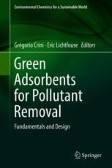Search
Search Results
-
Microbes and microbial strategies in carcinogenic polycyclic aromatic hydrocarbons remediation: a systematic review
Degradation, detoxification, or removal of the omnipresent polycyclic aromatic hydrocarbons (PAHs) from the ecosphere as well as their prevention...

-
Biodegradation and detoxification of phenanthrene in in vitro and in vivo conditions by a newly isolated ligninolytic fungus Coriolopsis byrsina strain APC5 and characterization of their metabolites for environmental safety
Polycyclic aromatic hydrocarbons (PAHs) are recalcitrant organic pollutants generated from agricultural, industrial, and municipal sources, and their...

-
Microbial remediation of petroleum-contaminated soil focused on the mechanism and microbial response: a review
The environmental pollution caused by petroleum hydrocarbons has received considerable attention in recent years. Microbial remediation has emerged...

-
Ligninolytic enzyme involved in removal of high molecular weight polycyclic aromatic hydrocarbons by Fusarium strain ZH-H2
The capacity of Fusarium sp. strain ZH-H2 to secret lignin peroxidase (LiP), laccase (Lac), and manganese peroxidase (MnP) and degrade high molecular...

-
Advanced bioremediation by an amalgamation of nanotechnology and modern artificial intelligence for efficient restoration of crude petroleum oil-contaminated sites: a prospective study
Crude petroleum oil spillage is becoming a global concern for environmental pollution and poses a severe threat to flora and fauna. Bioremediation is...

-
Biochemical Methods for Water Purification
Prompt amplification in industrialization and population has resulted in the heightened discharge of polluted water containing heavy metals, dyes,...
-
Biodegradation of anthracene and different PAHs by a yellow laccase from Leucoagaricus gongylophorus
Laccases produced by Leucoagaricus gongylophorus act in lignocellulose degradation and detoxification processes. Therefore, the use of L. gongylophorus ...

-
Remediation of Polycyclic Aromatic Hydrocarbons Using Nanomaterials
Polycyclic aromatic hydrocarbons are major contaminants in environmental bodies due to ubiquitous occurrence, toxicity and potential to...
-
Molecular dissection of novel anthocyanin transcripts HsCHS and HsF3H from the calyx tissue of Hibiscus sabdariffa L.
Flavonoids are polyphenolic compounds commonly found in vegetables as well as fruits and contribute significantly in the human diet. The calyx of...

-
Filamentous Fungi Isolates of Contaminated Sediment in the Amazon Region with the Potential for Benzo(a)pyrene Degradation
Filamentous fungi were isolated from contaminated sediment samples in the Amazon region of Brazil to select species with potential for benzo(a)pyrene...

-
Potential microbial applications of co-cultures involving ligninolytic fungi in the bioremediation of recalcitrant xenobiotic compounds
Recalcitrant xenobiotic compounds are a major source of concern due to their resistance to degradation and persistency in the environment. Xenobiotic...

-
HC-0C-03: Biological Treatments to Improve the Quality of Heavy Crude Oils
Petroleum or crude oil is a crucial source of energy and one of the main factors driving the World’s economy. The progressive depletion of...
-
Isolation and application of predatory Bdellovibrio-and-like organisms for municipal waste sludge biolysis and dewaterability enhancement
Bdellovibrio -and-like organisms (BALOs) are a group of ubiquitous and obligate predatory bacteria and commonly used as biocontrol agents. In this...

-
Biodegradation and Identification of Transformation Products of Fluorene by Ascomycete Fungi
Fluorene belongs to the polycyclic aromatic hydrocarbons (PAHs) which are potentially carcinogenic or mutagenic. However, very few studies on...

-
Composition and morphology characterization of exopolymeric substances produced by the PAH-degrading fungus of Mucor mucedo
To explore the role of exopolymeric substances (EPS) in the process of polycyclic aromatic hydrocarbons (PAH) biodegradation, the characteristics of...

-
Efficiency of Indigenous Filamentous Fungi for Biodegradation of Petroleum Hydrocarbons in Medium and Soil: Laboratory Study from Ecuador
The competence of two fungal isolates for degrading petroleum hydrocarbons was evaluated. The filamentous fungi were isolated from a crude...

-
Enhanced Degradation of Pyrene and Metabolite Identification by Pleurotus eryngii F032
Pyrene, a four-ring polycyclic aromatic hydrocarbon that is highly resistant to degradation, persists in the environment and exerts its harmful...

-
Breakdown Products in the Metabolic Pathway of Anthracene Degradation by a Ligninolytic Fungus Polyporus sp. S133
Polyporus sp. S133 fungi were selected based on their ability to degrade anthracene in liquid media. The degradation efficiency of anthracene...

-
Acceleration of Anthraquinone-Type Dye Removal by White-Rot Fungus Under Optimized Environmental Conditions
The decolorization of the recalcitrant dye Remazol Brilliant Blue R (RBBR) by the culture filtrate of Polyporus sp. S133 and the effect of various...

-
Controlling microbiological interfacial behaviors of hydrophobic organic compounds by surfactants in biodegradation process
Bioremediation of hydrophobic organic compounds (HOCs) contaminated soils involves several physicochemical and microbiological interfacial processes...
